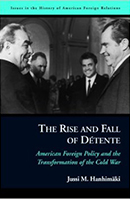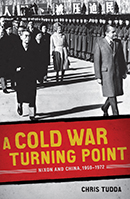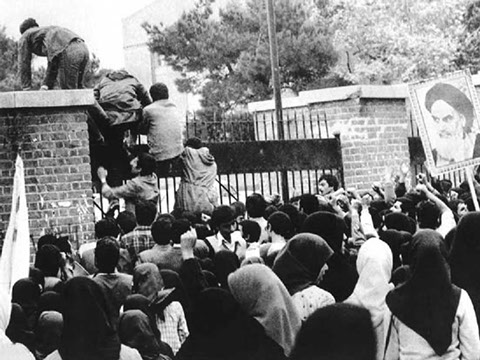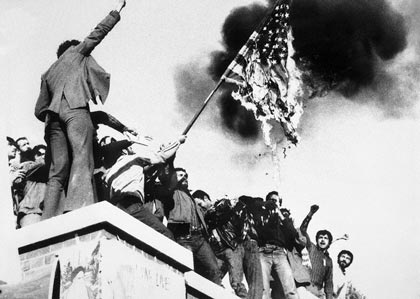The Dominoes that Toppled Tehran
By George Parampathu

David Patrick Houghton
David Patrick Houghton is currently a Senior Lecturer in Defence Studies at King’s College London. Houghton received a doctorate from the University of Pittsburgh in 1996.His areas of expertise include political psychology, foreign policy decision-making, and US-Iranian relations.




“Death to America.” “Death to the Shah.” Those were the cries that escaped the lips of the 300 or so Iranian university students marching in protest outside the U.S. embassy in Tehran, a plea that served as a warning for those in the embassy and in Washington if there wasn’t a “failure to understand the vast degree of suppressed hatred that had been caused by [the U.S.] bringing about the collapse of the Mossadegh government.”1 In his book, U.S. Foreign Policy and the Iran Hostage Crisis, David Patrick Houghton explains the impact of historical analogies, such as the 1953 CIA-assisted coup d’etat of Iranian Prime Minister Mohammad Mosaddegh, on the minds of the decision-makers in both the U.S. and Tehran before and during the 444-day Iran Hostage Crisis under the Carter administration. With these historical analogies, Houghton attempts to discover the rationale behind several political actions that were uncharacteristic of the decision-makers involved.
Houghton begins his work by explaining his theory of historical analogies and examining the use of existing literature. Decision-makers utilize historical analogies, that is recollections of past historical events from their personal or observed experiences that parallel a current situation, to make sense of a complex reality. William James, a famous American psychologist, describes the use of historical analogies by saying, “humans can understand things, events, and experiences only from and through the viewpoint of other things, events, and experiences.”2 Policy making, which can be seen as a method of human problem solving, is a situation in which historical analogies are potentially significant. Houghton refers to the use of analogies in foreign policy as “common practice” while also analyzing the theory by saying, “an analogy is not simply a statement that something is like something else, rather, it is a comparison in which the subject assumes that the perceived similarities are structural as opposed to superficial.”3, 4 The practice of examining historical analogies provides a policy maker with six benefits: defining the nature of the situation confronting an individual, assessing the stakes at hand, providing prescriptions, predicting the chances of success, evaluating moral rightness, and serving as a warning about the dangers associated with the options. In Jimmy Carter’s situation, the decision-making over the hostage crisis took the form of an “ill-structured task” in which the motivation of the hostage takers, their future behaviour, the fate of the hostages, and the outcome of various policy options available to the American decision-makers were all highly uncertain.5
After concluding his section detailing the general points about historical analogies, Houghton begins to discuss the Carter administration’s failures and the origins of the crisis. On November 4, 1979, Iranian protesters seized the U.S. Embassy, holding 66 staff members blindfolded and at gun point. The media immediately drew attention to the situation. CBS’s Walter Cronkite signed off each broadcast by stating the number of days the hostage crisis had persisted, and ABC’s Ted Koppel’s created the show Nightline to detail the latest developments with the situation. Americans bought yellow ribbons to tie around oak trees to commemorate the hostages and purchased Iranian flags for public burnings. Meanwhile, in Washington, the Carter administration attempted peaceful negotiations with Ruhollah Moosavi Khomeini, the leader of the Iranian Revolution of 1979. However, after five months without progress, Carter approved of a military rescue that would become the greatest disaster of his presidency. The mission would be cancelled mid-operation, causing a confusion in which one military helicopter crashed, killing eight service men. The following morning, Carter stood before the people on national television informing them of the tragedy. However, sticking with the idea that the American people must rally behind their president in times of crisis, Carter’s approval rate nearly doubled from 32 percent to 61 percent. But what motivated those university students to seize the embassy in the first place, and what caused the Iranian government in power, under Khomeini, not to intervene? Houghton poses three plausible explanations in his book. First, the students were calling for the return shah Mohammad Reza Pahlavi from the U.S. After initially fleeing Iran, the Pahlavi had searched for refuge in multiple countries, eventually finding a safe haven when he was admitted into the U.S. for medical purposes. The flaw in this proposal is that Khomeini refused to negotiate with Carter’s representatives, and if the true purpose was to return the shah, then the Iranian government would have offered up a “quid pro quo”, a compromise. Khomeini “understood very well that Jimmy Carter could not extradite the shah to Iran as demanded and therefore that this was not a real condition for the release of the hostages.”6 Second, the radical Islamic students were ideologically opposed to the U.S. and acted irrationally. However, this completely ignores the political tension of the time period between the U.S. and Iran as a result of the 1953 coup d’etat. Third, and most probable, the students were trying to stop any attempt at a U.S.-headed counterrevolution. After the shah was admitted into the U.S., college students who believed that the U.S. was interested in returning the shah to the throne began to gain some traction with the general student body. This theory also proposed that Khomeini did not know about the plans to seize the embassy before the event occurred. However, after assessing the political advantages and disadvantages, Khomeini made a decision to support the students. The idea that “the whole thing was done for the internal political reasons to galvanize and unify the country against the Americans” is the most acceptable of the three.7
The next question posed is, who or what persuaded Carter, a pacifist, to approve of a military rescue mission and what other factors lead to the operation disaster? Previously, when an embassy is seized by a third party, the local government usually re-establishes U.S. power over the embassy in a timely fashion. Therefore, during the first few days of the hostage crisis, both the hostages and officials in Washington thought the ordeal would swiftly pass. However, Khomeini not only refused to help return the embassy, but he also began to endorse its capture—defying all rules of diplomacy. This made it clear that U.S. intervention was required, so U.S. officials began proposing potential plans. There were seven prospective plans created: get the Pahlavi out of the U.S., attempt to negotiate with Khomeini, implement a naval blockade, launch an airstrike, seize Iranian mine and oil depots, or initiate a military rescue mission. The two seriously considered options were negotiation and the rescue mission. Advocates of a rescue mission, including National Security Adviser Zbigniew Kazimierz Brzezinski, looked towards Israel’s successful Operation Entebbe, which rescued 102 hostages at the cost of only one soldier’s life. Chairman of the Joint Chiefs of Staff Omar Bradley responded by outlining four points against a rescue mission. First, a rescue mission would be extremely difficult given the location. Second, the undertaking of such military action would involve a conflict with the civil and military forces of the area. Third, failure of the U.S.S.R. to become involved and defend the Iranians was unlikely. Finally, covert action would not correspond to the attitude of the United States. Given Carter’s own moral beliefs, he was predispositioned towards peaceful resolutions, as was his Secretary of State Cyrus Vance. Vance believed the hostages would be released as soon as they lost their importance as a political tool. Unfortunately, Carter did not see eye-to-eye with him stating, “it was obvious to me that the Revolutionary Council would never act and that, in spite of all our work and the efforts of the elected leaders of Iran, the hostages were not going to be released.”8 After five months of useless negotiations and with the next election around the corner, there was “rising public pressure for more direct action against Iran.”9 After giving permission to send a secret exploratory flight over Tehran, Carter stated, “it was time to bring the hostages home; their safety and our national honor were at stake.”10
Houghton continues by providing a few alternate reasons to explain Carter’s actions. It is clear that Carter faced pressure from public media, such as CBS’s Walter Cronkite and ABC’s Ted Koppel, and he may have been feeling political pressure from his administrative staff as well. After his approval rate jumped to 61 percent, it dropped down to around 40 percent by April 1980 because of public dissatisfaction regarding the lack of American action. “If Carter had taken a very extreme, firm position, a declaration of war, an immediate naval blockade or some such thing, that could have won him the presidential election in 1980,” since the public wished to see tangible proof that the U.S. was trying to retaliate during the hostage crisis.11 This attitude to remain in office may have lead to what Houghton calls “groupthink”, a tendency, which occurs in some groups, to reach premature consensus without having fully thought through the complete range of available options or their implications. With the public wanting to see action and with military rescue being a plausible option, Carter may have chosen to compromise his personal ideals in order to solve the conflict at hand and attempt to secure his position in the future. Groupthink would also explain why Vance was one of the few proponents of stalling the hostage crisis because his position would not be affected by the next election.
Throughout U.S. Foreign Policy and the Iran Hostage Crisis, Houghton backs his arguments and conclusions using historical analogies to emphasize their significance on the mindsets of decision-makers. One of the most significant historical analogies cited in this work is that of the 1953 CIA-assisted coup d’etat of Iranian Prime Minister Mohammad Mosaddegh. One of the greatest fears of the supporters of the Iranian Revolution of 1979 was “ that Carter and Vance would step in to crush the revolution and to re-establish the position of the shah in 1979 as Eisenhower and Dulles had done in 1953.”12 Although the U.S. intervention that occurred in 1953 was not publicized or praised at home, “on the Iranian side, ghostly images of 1953 haunted the streets of revolutionary Iran, providing the major motivation behind the attempt to prevent a CIA coup the radical students believed was surely imminent.”13 The “attempt to prevent a CIA coup” mentioned was the invasion of the U.S. Embassy which the students thought was a CIA “spy nest.”13 Houghton mentions that, “in the extremists’ eyes taking the American diplomats hostage was the only way to prevent a repetition of 1953.”14 Some important analogies that affected the American perspective included events, such as the Pueblo incident, Mayaguez incident, and the Entebbe operation. The Pueblo incident, supported by Vance, suggested that once hostages lost their political significance, they were useless for hostage holders and would be released. The Mayaguez incident, which may have affected those who were opposed to a premature military rescue, was a situation in which a military rescue plan was enacted while the hostages were already scheduled to be released, leading to the unnecessary deaths of 14 U.S. service men, 13-25 of the hostage takers, and an unknown amount of civilians. On the other hand, the Entebbe operation, as mentioned above, supported the idea of a military rescue as it had been successful with Israel’s forces. Lastly, Carter having come from an evangelist Christian faith and having witnessed the Civil Rights Movement of the 1960s, was a moralistic character who was committed to non-military tactics. However, persuaded by his advisers and their historical evidence, Carter disbanded his beliefs to support the option he thought would be most successful. In a speech on April 21, 1980, Carter stated, “I have studied all the previous occurrences in my lifetime when American hostages have been taken… to learn how we reacted and what the degree of success was,” adding credibility to the idea that the decision-makers were looking to the past for direction.15
Houghton’s focus on the psychological aspect of history can be traced back to his university education. Houghton received a bachelor’s degree in politics, followed by a master’s and doctorate degree in political science. His areas of expertise include “political psychology and international security, with a particular focus on foreign policy decision-making, British and American foreign policy and U.S.-Iranian relations.”16 As if to foreshadow his future emphasis on historical analysis, his doctorate thesis was titled “The Role of Analogical Reasoning in Foreign and Domestic Policy Contexts”. Gaining the majority of his higher education in the U.S. during the 1990s, Houghton may have found interest in President Clinton’s foreign policy as it extended toward the Palestine-Israel conflict. One year after being published in 2001, U.S. Foreign Policy and the Iran Hostage Crisis was awarded the 2002 Choice Outstanding Academic title.
Barbara Farnham’s review states, “the book provides a clear account of the analogical reasoning model and uses available resources well to provide an interesting description of the deliberations in the Carter administration surrounding the Iranian hostage crisis.”17 However, Houghton himself labeled his arguments as “strongly suggestive rather than definitive,” given the fact that the majority of relevant CIA and presidential documents remain classified.18 This leads Farnham to believe that the book does not demonstrate that analogies played a determinative role in the decision-making process as a whole. Raymond Tanter’s review also views the basis of Houghton’s arguments to be a inconclusive, however states that “the book is fascinating because of the manner in which the author casts his questions—as puzzles to be solved.”19 Both reviewers credit Houghton effort to display the importance of historical analogies given the data available to him, but state that his argument as a whole is not satisfactory.
Houghton offers an interesting perspective into the minds of decision-makers who decide the fate of a nation’s history. Although Houghton states that chapter two is a “precursor to the argument rather than the argument itself” that the reader can skip “without impairing comprehension of the book as a whole,” this chapter gives the uninformed reader a summary of the theory of historical analogies that adds credibility to Houghton’s implications in future chapters.20 Houghton provides the reader with a solid basis of background of previous historical context through which the reader can derive a relation to the decisions made in the era the book focuses on. U.S. Foreign Policy and the Iran Hostage Crisis provokes the reader to think critically and truly value the effect of the past on the minds of those in power. Although there is only one possible explanation for the rationale behind foreign policies, Houghton presents a persuasive argument.
The hostage crisis and the rescue mission would become “the greatest disaster of Carter’s presidency.”21 Other than disapproval from the federal government, there were no domestic issues related to the hostage situation. However “the seemingly insoluble foreign and economic policy difficulties meshed together to create the inevitable appearance of a well-intentioned but ultimately failed presidency,” creating a crisis for Carter and his administration more so than the nation as a whole.22 This circumstance came as a continuation of the past U.S.-Iran relations. The U.S. from 1942 onwards began to play an increasingly active role in Iran. Tensions climaxed with the 1953 CIA-assisted coup d’etat, which Iran saw as “a clear violation of its political sovereignty.”23 Houghton concludes that “generations of Iranians were brought up in the shadow of 1953…, it became a defining experience and a rallying point” for the seizing of the U.S. embassy in Tehran.24
Using the crisis as a case study, Houghton concludes that “the persuasiveness of an analogy does not depend simply on its cognitive appeal, however, but on the extent to which it is compatible with the belief systems, political priorities and/or bureaucratic interests” that are in play.25 When it came to the Iran Hostage Crisis, the precedents set by past situations seemed to parallel what was occurring as well as be accepted by the political atmosphere of the time. Had the Carter administration not have heeded the historical analogies presented, the hostage situation may not have become a crisis and may not have diminished the public view of Carter. In U.S. Foreign Policy and the Iran Hostage Crisis, Houghton effectively expresses the importance of both the Iran Hostage Crisis and the historical analogies that contributed to its nuances.
Footnotes:
- Houghton, David Patrick. US Foreign Policy and the Iran Hostage Crisis. Cambridge: Cambridge UP, 2001. 65.
- Houghton, David Patrick. 21.
- Houghton, David Patrick. 31.
- Houghton, David Patrick. 26.
- Houghton, David Patrick. 37.
- Houghton, David Patrick. 53.
- Houghton, David Patrick. 53.
- Houghton, David Patrick. 109.
- Houghton, David Patrick. 110.
- Houghton, David Patrick. 127.
- Houghton, David Patrick. 177.
- Houghton, David Patrick. 60.
- Houghton, David Patrick. 144.
- Houghton, David Patrick. 62.
- Houghton, David Patrick. 144.
- “King’s College London - Homepage.” King’s College London. King’s College London, 2015. Web. 30 May 2015.
- Farnham, Barbara. “Political Science Quarterly.” JSTOR. The Academy of Political Science, 2002. Web. 29 May 2015.
- Houghton, David Patrick. 64.
- Tanter, Raymond. “Review of US Foreign Policy and the Iran Hostage Crisis.” Middle East Forum. The Middle East Forum, Dec. 2006. Web. 29 May 2015.
- Houghton, David Patrick. 22.
- Houghton, David Patrick. 2.
- Houghton, David Patrick. 4.
- Houghton, David Patrick. 59.
- Houghton, David Patrick. 59.
- Houghton, David Patrick. 203.




4 - 4
<
>